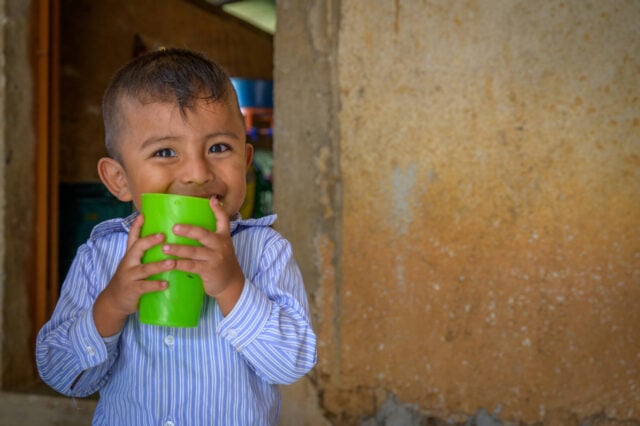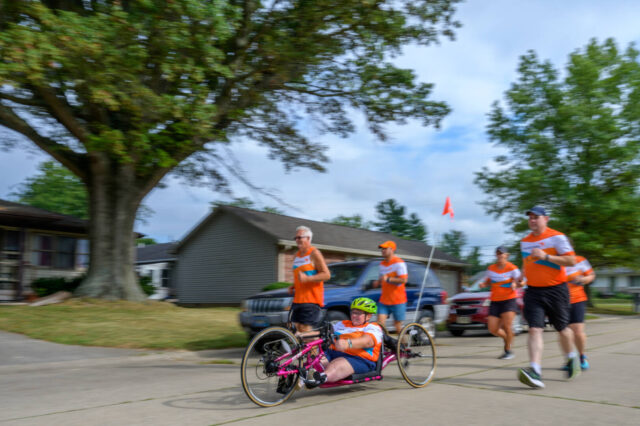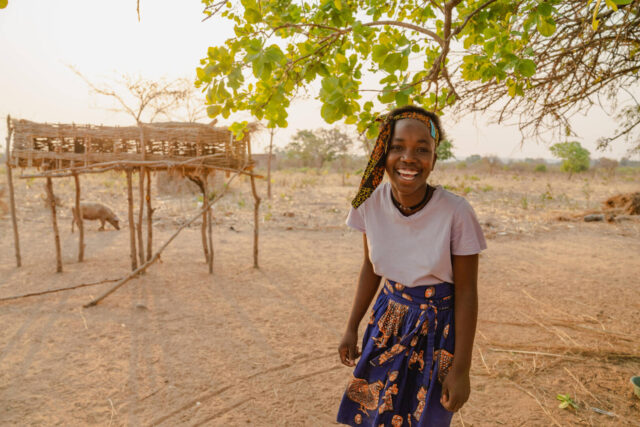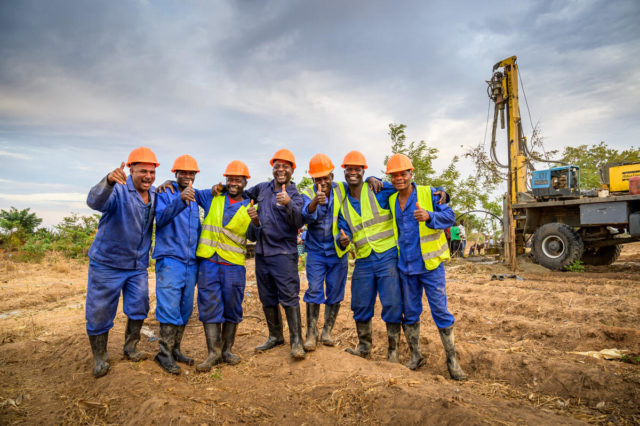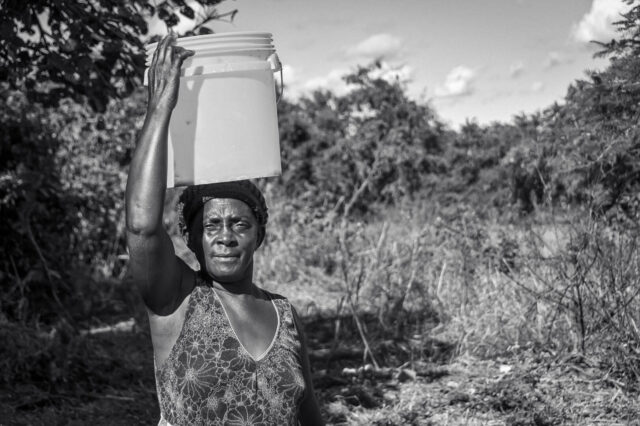
Clean Water
Water Changes Everything for Nuumbo
World Vision’s COVID-19 Response - 2021 WASH Forum
Nearly 3.1 million
people empowered with lasting access to clean water.
Thanks to the support of World Vision donors around the world in 2023.
2.9 million
people supported with access to household handwashing facilities.
Thanks to the support of World Vision donors around the world in 2023.
Nearly 2.5 million
people equipped with access to sanitation facilities.
Thanks to the support of World Vision donors around the world in 2023.
Our Water, Sanitation, and Hygiene Approach
How does World Vision determine where to implement WASH programs?
World Vision is committed to serving the most vulnerable, especially in countries where extreme poverty and political instability have hampered investments in water, sanitation, and hygiene (WASH) services. World Vision implements WASH programs in countries where we operate that identify WASH as a critical need to improve child well-being, and we invest resources where that need overlaps most with fragility. As evidence of this, World Vision’s global WASH business plan directs 89% of funding toward fragile contexts.
However, our call to serve the most vulnerable goes beyond fragile states and includes a deepened focus on the most vulnerable children in every country where we work. These children are those whose quality of life and ability to fulfil their potential are most affected by extreme deprivation and violation of their rights. They often live in traumatic situations with relationships characterized by violence, abuse, neglect, exploitation, exclusion, and discrimination. World Vision defines and identifies the most vulnerable according to the challenges and vulnerabilities of their local context, and then designs and implements programs to meaningfully impact their well-being.
Learn more about World Vision’s work in fragile contexts.
How does World Vision measure its WASH program achievements and impact?
To uphold its core value of accountability, World Vision aligns its monitoring approach with guidelines and definitions set forth by the World Health Organization and UNICEF Joint Monitoring Programme for Sustainable Development Goal (SDG) 6, supporting the global effort to track progress toward equitable WASH services. For example, when reporting the number of people reached with clean water, we include only those who walk 30 minutes or less roundtrip to access clean water. World Vision tracks the number of people benefiting from each of the three areas of WASH (water, sanitation, and hygiene) in communities, schools, and healthcare facilities. Participant numbers for WASH services provided at households and schools are the people who use these services daily. For healthcare facilities, the people reached is the population each facility exists to serve. When reporting aggregate numbers, World Vision seeks to avoid double-counting people served in multiple settings.
Monitoring doesn’t end when a WASH project is complete. We utilize a vast network of government staff, community leaders, engineers, maintenance technicians, and World Vision staff who provide ongoing monitoring. Further, World Vision is committed to increasing our use of advanced technology to build evidence of sustainability. We continue working with leading research institutions to evaluate and measure long-term program impact, including our 14-country World Vision WASH evaluation conducted in 2017 by the Water Institute at the University of North Carolina. Read more about this study here.
How does World Vision’s programming promote healthy WASH behaviors?
World Vision integrates behavior-change programming into its WASH work in communities, schools, and healthcare facilities to alter social perceptions and norms that can transform communities and achieve sustained impact. We also create physical environments with associated operation and maintenance approaches that support and sustain new behaviors. Behavior-change approaches are guided by the local context and focus on adoption of essential WASH behaviors, such as handwashing with soap and running water at critical times; safe construction and proper use of latrines; and safe treatment, handling, and storage of drinking water. One way we deliver behavior-change messages is by engaging and mobilizing community leaders and influencers, including faith leaders, educators, mothers in leadership positions, and community health workers.
Behavior-change programming is especially important during disease outbreaks, such as COVID-19 and Ebola. For example, integrating behavior-change programming with WASH response efforts in schools and healthcare facilities helps ensure disinfection of facilities and promotes sustainable healthy handwashing behaviors. This is essential for containing outbreaks and reducing disease transmission, improving education and healthcare quality, and saving lives. In addition, when people are healthy, they have more time to engage in economic activities, which is important as communities recover economically from the COVID-19 pandemic. Learn more about our behavior-change approach here.
How does World Vision ensure gender equality and social inclusion in its WASH work?
World Vision is committed to gender equality and social inclusion (GESI) in our WASH programming and staffing. Our GESI approach actively strives to examine, question, and change harmful social norms and power imbalances as a means of reaching GESI objectives. These objectives include access to infrastructure and participation in management structures, as well as more transformative elements, including systems change, equal decision-making, and overall improvement in well-being for all people.
For example, World Vision collaborates with Sesame Workshop to provide Girl Talk, a program that educates and models girls’ empowerment and menstrual hygiene management, and addresses myths and misconceptions about puberty. In addition, World Vision’s disability-inclusive WASH programming supports SDG 6.2—adequate and equitable sanitation and hygiene that is accessible for all, especially the most vulnerable. People of varying ability levels are included in the planning process for design and location of institutional latrines to ensure they are accessible to all, and community members with physical disabilities are supported with accommodations such as seats to make daily latrine use easier and more dignified. Learn more about World Vision’s GESI work here.
What is World Vision’s approach to WASH in schools and healthcare facilities?
Our WASH in schools programming integrates WASH interventions together with approaches from the education sector to jointly support both SDG 6 (safe water and sanitation for all) and 4 (quality education for all). World Vision strives to meet or exceed criteria for basic WASH coverage in schools, including the presence of improved water that is piped on-site, equitable and accessible sanitation facilities sufficient for the school population, accessible handwashing stations with soap, and facilities to manage menstrual hygiene in privacy and with dignity. World Vision’s WASH in schools work often is delivered through school WASH clubs, as well as the Sesame WASH UP! program. WASH UP! teaches children how to practice and share healthy WASH habits through play by engaging with child-friendly learning materials featuring the Sesame characters Raya and Elmo. We also work with communities and local government to enhance management and financing for school WASH sustainability.
World Vision’s focus on WASH in healthcare facilities helps prevent and control infections and outbreaks, improve healthcare quality, promote healthcare best practices, and save lives. Our work aligns with the universal health coverage targets of SDG 3 (good health and well-being)—particularly the goals of increasing rates of safe childbirth and decreasing neonatal mortality. World Vision’s WASH in healthcare facilities work is often delivered through BabyWASH, an initiative that integrates WASH with maternal, newborn, and child health; nutrition; and early childhood development interventions to achieve greater impact for mothers and children to improve health outcomes and survival in the first 1,000 days of life.
Since most healthcare facilities are part of the government healthcare system, we advocate with local government officials to build the capacity of healthcare providers, monitor services for accountability, plan for catastrophic events, and set aside sufficient budget for long-term sustainability of quality health systems. Read more about World Vison’s WASH in healthcare facilities work here.
Clean Water Resources
Improving WASH programming through evidence-building
In the largest evaluation of water, sanitation, and hygiene programming to date, World Vision and the University of North Carolina Water Institute partnered to assess 36,000 households, 2,532 water points, 2,691 schools, and 2,035 healthcare facilities in 14 countries. Read the results.
Applying continuous quality improvement methods to water service delivery
An evaluation of World Vision’s continuous quality improvement programming in Ghana by the University of North Carolina found that the interventions of safe water storage containers, refresher training for WASH committees, and replacement of missing maintenance tools increased household water conformity to WHO safe drinking water standards from 17% to 40%, which persisted for two years post-implementation.
Providing water for gari processing firm in Ghana
Maintaining hygiene against the spread of coronavirus
Nearly 3.1 million
people empowered with lasting access to clean water.
Thanks to the support of World Vision donors around the world in 2023.
2.9 million
people supported with access to household handwashing facilities.
Thanks to the support of World Vision donors around the world in 2023.
Nearly 2.5 million
people equipped with access to sanitation facilities.
Thanks to the support of World Vision donors around the world in 2023.
Our Water, Sanitation, and Hygiene Approach
How does World Vision determine where to implement WASH programs?
World Vision is committed to serving the most vulnerable, especially in countries where extreme poverty and political instability have hampered investments in water, sanitation, and hygiene (WASH) services. World Vision implements WASH programs in countries where we operate that identify WASH as a critical need to improve child well-being, and we invest resources where that need overlaps most with fragility. As evidence of this, World Vision’s global WASH business plan directs 89% of funding toward fragile contexts.
However, our call to serve the most vulnerable goes beyond fragile states and includes a deepened focus on the most vulnerable children in every country where we work. These children are those whose quality of life and ability to fulfil their potential are most affected by extreme deprivation and violation of their rights. They often live in traumatic situations with relationships characterized by violence, abuse, neglect, exploitation, exclusion, and discrimination. World Vision defines and identifies the most vulnerable according to the challenges and vulnerabilities of their local context, and then designs and implements programs to meaningfully impact their well-being.
Learn more about World Vision’s work in fragile contexts.
How does World Vision measure its WASH program achievements and impact?
To uphold its core value of accountability, World Vision aligns its monitoring approach with guidelines and definitions set forth by the World Health Organization and UNICEF Joint Monitoring Programme for Sustainable Development Goal (SDG) 6, supporting the global effort to track progress toward equitable WASH services. For example, when reporting the number of people reached with clean water, we include only those who walk 30 minutes or less roundtrip to access clean water. World Vision tracks the number of people benefiting from each of the three areas of WASH (water, sanitation, and hygiene) in communities, schools, and healthcare facilities. Participant numbers for WASH services provided at households and schools are the people who use these services daily. For healthcare facilities, the people reached is the population each facility exists to serve. When reporting aggregate numbers, World Vision seeks to avoid double-counting people served in multiple settings.
Monitoring doesn’t end when a WASH project is complete. We utilize a vast network of government staff, community leaders, engineers, maintenance technicians, and World Vision staff who provide ongoing monitoring. Further, World Vision is committed to increasing our use of advanced technology to build evidence of sustainability. We continue working with leading research institutions to evaluate and measure long-term program impact, including our 14-country World Vision WASH evaluation conducted in 2017 by the Water Institute at the University of North Carolina. Read more about this study here.
How does World Vision’s programming promote healthy WASH behaviors?
World Vision integrates behavior-change programming into its WASH work in communities, schools, and healthcare facilities to alter social perceptions and norms that can transform communities and achieve sustained impact. We also create physical environments with associated operation and maintenance approaches that support and sustain new behaviors. Behavior-change approaches are guided by the local context and focus on adoption of essential WASH behaviors, such as handwashing with soap and running water at critical times; safe construction and proper use of latrines; and safe treatment, handling, and storage of drinking water. One way we deliver behavior-change messages is by engaging and mobilizing community leaders and influencers, including faith leaders, educators, mothers in leadership positions, and community health workers.
Behavior-change programming is especially important during disease outbreaks, such as COVID-19 and Ebola. For example, integrating behavior-change programming with WASH response efforts in schools and healthcare facilities helps ensure disinfection of facilities and promotes sustainable healthy handwashing behaviors. This is essential for containing outbreaks and reducing disease transmission, improving education and healthcare quality, and saving lives. In addition, when people are healthy, they have more time to engage in economic activities, which is important as communities recover economically from the COVID-19 pandemic. Learn more about our behavior-change approach here.
How does World Vision ensure gender equality and social inclusion in its WASH work?
World Vision is committed to gender equality and social inclusion (GESI) in our WASH programming and staffing. Our GESI approach actively strives to examine, question, and change harmful social norms and power imbalances as a means of reaching GESI objectives. These objectives include access to infrastructure and participation in management structures, as well as more transformative elements, including systems change, equal decision-making, and overall improvement in well-being for all people.
For example, World Vision collaborates with Sesame Workshop to provide Girl Talk, a program that educates and models girls’ empowerment and menstrual hygiene management, and addresses myths and misconceptions about puberty. In addition, World Vision’s disability-inclusive WASH programming supports SDG 6.2—adequate and equitable sanitation and hygiene that is accessible for all, especially the most vulnerable. People of varying ability levels are included in the planning process for design and location of institutional latrines to ensure they are accessible to all, and community members with physical disabilities are supported with accommodations such as seats to make daily latrine use easier and more dignified. Learn more about World Vision’s GESI work here.
What is World Vision’s approach to WASH in schools and healthcare facilities?
Our WASH in schools programming integrates WASH interventions together with approaches from the education sector to jointly support both SDG 6 (safe water and sanitation for all) and 4 (quality education for all). World Vision strives to meet or exceed criteria for basic WASH coverage in schools, including the presence of improved water that is piped on-site, equitable and accessible sanitation facilities sufficient for the school population, accessible handwashing stations with soap, and facilities to manage menstrual hygiene in privacy and with dignity. World Vision’s WASH in schools work often is delivered through school WASH clubs, as well as the Sesame WASH UP! program. WASH UP! teaches children how to practice and share healthy WASH habits through play by engaging with child-friendly learning materials featuring the Sesame characters Raya and Elmo. We also work with communities and local government to enhance management and financing for school WASH sustainability.
World Vision’s focus on WASH in healthcare facilities helps prevent and control infections and outbreaks, improve healthcare quality, promote healthcare best practices, and save lives. Our work aligns with the universal health coverage targets of SDG 3 (good health and well-being)—particularly the goals of increasing rates of safe childbirth and decreasing neonatal mortality. World Vision’s WASH in healthcare facilities work is often delivered through BabyWASH, an initiative that integrates WASH with maternal, newborn, and child health; nutrition; and early childhood development interventions to achieve greater impact for mothers and children to improve health outcomes and survival in the first 1,000 days of life.
Since most healthcare facilities are part of the government healthcare system, we advocate with local government officials to build the capacity of healthcare providers, monitor services for accountability, plan for catastrophic events, and set aside sufficient budget for long-term sustainability of quality health systems. Read more about World Vison’s WASH in healthcare facilities work here.
Clean Water Resources
Improving WASH programming through evidence-building
In the largest evaluation of water, sanitation, and hygiene programming to date, World Vision and the University of North Carolina Water Institute partnered to assess 36,000 households, 2,532 water points, 2,691 schools, and 2,035 healthcare facilities in 14 countries. Read the results.
Applying continuous quality improvement methods to water service delivery
An evaluation of World Vision’s continuous quality improvement programming in Ghana by the University of North Carolina found that the interventions of safe water storage containers, refresher training for WASH committees, and replacement of missing maintenance tools increased household water conformity to WHO safe drinking water standards from 17% to 40%, which persisted for two years post-implementation.
Ways to Give to Clean Water
Share of a deep well
What’s the first thing our well-drilling teams do when they come to a thirsty community? Pray. They know that dirty water and poor sanitation and hygiene result in the deaths of more than 800 children every day.
Help one of our teams rig-drill a deep well and fit it with a hand pump. One well can provide 2,800 gallons of clean, life-sustaining water every day for as many as 300 people. Your gift to help drill a deep well will contribute to saving lives for years to come.
Become a Clean Water Partner
You can help kids and families experience the transformation that comes when communities get clean water. World Vision is the leading nongovernmental provider of clean water in the developing world. Thanks to partners like you, we’re reaching one new person every 10 seconds with clean water — and we have an ambitious but achievable plan to help end the global water crisis within our lifetimes.
Every $1 you give to the Clean Water Fund has the impact of $5, thanks to support from public grants, child sponsorship, foundations, and corporations.
Monthly giving is the most effective way to help children and families who need it most. Plus, it lowers costs, which means more of your gift helps kids!
Ways to Give to Clean Water
Provide clean water and sanitation: $30+
Giving to the Clean Water Fund will help bring clean water, sanitation, and hygiene to communities — helping cut child deaths by more than half!
Monthly giving is the most effective way to help children and families who need it most. Plus, it lowers costs, which means more of your gift helps kids!
Become a Clean Water Partner
You can help kids and families experience the transformation that comes when communities get clean water. World Vision is the leading nongovernmental provider of clean water in the developing world. Thanks to partners like you, we’re reaching one new person every 10 seconds with clean water — and we have an ambitious but achievable plan to help end the global water crisis within our lifetimes.
Every $1 you give to the Clean Water Fund has the impact of $5, thanks to support from public grants, child sponsorship, foundations, and corporations.
Monthly giving is the most effective way to help children and families who need it most. Plus, it lowers costs, which means more of your gift helps kids!

